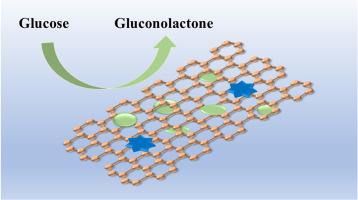Electrochemical biosensor based on copper sulfide/reduced graphene oxide/glucose oxidase construct for glucose detection
IF 2.6
4区 生物学
Q2 BIOCHEMICAL RESEARCH METHODS
引用次数: 0
Abstract
Due to the current increase in the number of people suffering from diabetes worldwide, how to monitor the blood glucose level in the human body has become an urgent problem to be solved nowadays. The electrochemical sensor method can be used for real-time glucose monitoring due to its advantages of real-time monitoring capability and high sensitivity. Reduced graphene oxide (rGO) has great potential for application in the field of sensors due to its advantages of large specific surface area, high stability, and good electrical and thermal conductivity. Meanwhile, the synergistic effect between two-dimensional transition metal sulfides and graphene can improve the electrochemical performance of materials due to their similar mechanical flexibility and strength. This article uses flake graphite, copper sulfate, and glucose oxidase (GOx) as raw materials to prepare CuS/rGO/GOx/GCE electrodes, and explores the performance of electrode electrocatalysis for glucose. The results showed that the prepared sensor was characterized by a low detection limit (1.75 nM) and a wide linear range (0.1–100 mM) for glucose detection, displaying a good overall detection performance, and its sensing mechanism and dynamic process were also investigated. In addition, the sensor has outstanding selectivity, anti-interference, repeatability, reproducibility and practicality.

基于硫化铜/还原氧化石墨烯/葡萄糖氧化酶构建的电化学生物传感器用于葡萄糖检测。
由于目前全球糖尿病患者人数的增加,如何监测人体血糖水平已成为当前亟待解决的问题。电化学传感器方法具有实时监测能力强、灵敏度高等优点,可用于葡萄糖的实时监测。还原氧化石墨烯(rGO)具有比表面积大、稳定性高、导电导热性好等优点,在传感器领域具有很大的应用潜力。同时,由于二维过渡金属硫化物与石墨烯具有相似的机械柔韧性和强度,二者之间的协同效应可以提高材料的电化学性能。本文以鳞片石墨、硫酸铜和葡萄糖氧化酶(GOx)为原料制备了 CuS/rGO/GOx/GCE 电极,并探讨了电极对葡萄糖的电催化性能。结果表明,所制备的传感器对葡萄糖的检测具有检出限低(1.75 nM)、线性范围宽(0.1-100 mM)的特点,显示出良好的整体检测性能,并对其传感机理和动态过程进行了研究。此外,该传感器还具有突出的选择性、抗干扰性、重复性、再现性和实用性。
本文章由计算机程序翻译,如有差异,请以英文原文为准。
求助全文
约1分钟内获得全文
求助全文
来源期刊

Analytical biochemistry
生物-分析化学
CiteScore
5.70
自引率
0.00%
发文量
283
审稿时长
44 days
期刊介绍:
The journal''s title Analytical Biochemistry: Methods in the Biological Sciences declares its broad scope: methods for the basic biological sciences that include biochemistry, molecular genetics, cell biology, proteomics, immunology, bioinformatics and wherever the frontiers of research take the field.
The emphasis is on methods from the strictly analytical to the more preparative that would include novel approaches to protein purification as well as improvements in cell and organ culture. The actual techniques are equally inclusive ranging from aptamers to zymology.
The journal has been particularly active in:
-Analytical techniques for biological molecules-
Aptamer selection and utilization-
Biosensors-
Chromatography-
Cloning, sequencing and mutagenesis-
Electrochemical methods-
Electrophoresis-
Enzyme characterization methods-
Immunological approaches-
Mass spectrometry of proteins and nucleic acids-
Metabolomics-
Nano level techniques-
Optical spectroscopy in all its forms.
The journal is reluctant to include most drug and strictly clinical studies as there are more suitable publication platforms for these types of papers.
 求助内容:
求助内容: 应助结果提醒方式:
应助结果提醒方式:


